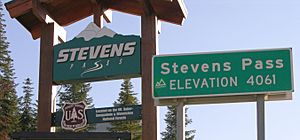List of mountain passes in Washington facts for kids
The state of Washington, located in the Pacific Northwest region of the United States, is known for its many mountain ranges. These include the Cascade Range, which divides the state, as well as the Olympic Mountains, Selkirk Mountains, and Blue Mountains. To travel across these tall mountains, people use special routes called passes. These passes are like natural gateways through the mountains, making it easier to get from one side to the other.
Contents
What are Mountain Passes?
A mountain pass is the lowest or easiest path through a mountain range. Imagine a giant wall of mountains; a pass is like a doorway or a dip in that wall. They are super important for travel, trade, and even for wildlife to move around. In Washington, these passes help connect different parts of the state, especially over the tall Cascade Range.
Why are Passes Important for Travel?
Mountain passes have been used for thousands of years by people and animals. They allow roads, railways, and hiking trails to cross difficult terrain. Without passes, traveling across Washington's mountains would be much harder and take a lot longer. They help people commute, transport goods, and even enjoy outdoor activities like skiing and hiking.
Famous Mountain Passes in Washington
Washington has many important mountain passes. Here are a few well-known ones:
Snoqualmie Pass: A Busy Gateway
Snoqualmie Pass is one of the most famous and busiest passes in Washington. It's located in the Cascade Range and is crossed by Interstate 90, a major highway. This pass is about 3,015 feet (919 meters) high. It connects the western and eastern parts of the state and is often used by travelers and trucks. In winter, it gets a lot of snow, making travel challenging, but it's kept open as much as possible.
Stevens Pass: A Scenic Route
Stevens Pass is another important pass in the Cascade Range, reaching an elevation of about 4,061 feet (1,238 meters). It's crossed by U.S. Route 2 and is known for its beautiful scenery. It's also home to a popular ski resort, making it a fun place for winter sports.
Chinook Pass: High and Historic
Chinook Pass is a very scenic pass in the Cascade Range, with an elevation of about 5,440 feet (1,658 meters). It's part of State Route 410 and offers amazing views of Mount Rainier. This pass is often closed during the winter months because of heavy snow, but it's a favorite for tourists and hikers in the warmer seasons.
White Pass: Connecting East and West
White Pass is located in the Cascade Range at about 4,478 feet (1,365 meters) high. It's crossed by U.S. Route 12. This pass is another key route connecting the eastern and western sides of Washington, especially for those traveling to or from the southern parts of the state.
Other Notable Passes
- Blewett Pass is in the Wenatchee Mountains and is about 4,124 feet (1,257 meters) high. It's crossed by U.S. Route 97.
- Cayuse Pass is another pass in the Cascade Range, about 4,833 feet (1,473 meters) high. It's near Chinook Pass and also offers great views.
- Sherman Pass is in the Kettle River Range and is the highest pass in Washington that stays open all year round, at 5,541 feet (1,689 meters).
These passes are vital for connecting communities, allowing people to explore the state's natural beauty, and supporting transportation across Washington's diverse landscapes.
See also


